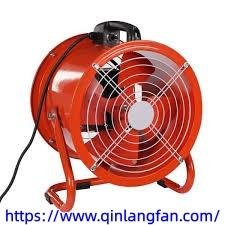Dynamic workplaces such as fabrication zones, confined mechanical stations, and seasonal maintenance fields operate in environments where airflow cannot remain passive, and sustained hand-controlled ventilation becomes essential for protecting personnel comfort and tool performance. When Qinlang introduces its focus on Handheld Axial Fan Supplier solutions, the consideration extends far beyond portable convenience, as operators frequently rely on directional air guidance to regulate heat pockets, channel temporary ventilation streams, and stabilize surrounding work temperatures during prolonged tasks that involve electrical instruments, metallic components, and enclosed chambers. The nature of these environments demands predictable airflow strength that does not falter under extended operation, compelling industries to evaluate how grip geometry, frame density, and blade balance influence real-world efficiency in complex settings.
In many industrial activities, airflow planning must account for narrow work corridors, uneven structures, and angles that cannot accommodate mounted ventilation systems. This increases the need for handheld equipment capable of rotating with the operator's wrist actions while still retaining internal balance without causing rapid fatigue. Advanced portability discussions emphasize details such as the center-weight location within the handle, the distribution of structural load across the housing shell, and the internal resistance generated when multistage speed adjustments transition between airflow intensities. These details shape the real value of portable directional fans used in restoration projects, heavy-duty cleaning, and temporary cooling tasks within production spaces that require flexible equipment rather than fixed installations.
Battery-centered airflow planning represents another analytical dimension, especially when operators must move continuously across separated stations or outdoor assignments lacking stable electrical sources. Instead of relying on the assumption that higher capacity always equals longer service time, industries examine how thermal build-up inside the battery compartment affects discharge stability, as well as how the fan's internal electrical architecture influences consumption at different operational intensities. Field workers often emphasize that endurance is not defined by battery numbers alone, but by the consistency of output power across prolonged cycles, especially when handheld movement increases mechanical resistance around the internal motor.
Environmental dust, metallic fragments, and vaporized residues arising from machining activities can introduce additional challenges regarding fan durability. Engineering discussions center around enclosure sealing, impact shock tolerance, and the long-term effects of micro-vibrations transmitted through the chassis during extended tasks. Even minor vibrations can accumulate structural stress, prompting equipment designers to evaluate shell curvature, reinforcing ribs, and vibration-isolating internal mounts that minimize fatigue for both user and machine. Stable airflow also relies on maintaining smooth rotations without mechanical drag, underscoring the relevance of precision-shaped blades, optimized shaft alignment, and a housing profile that guides air efficiently through challenging angles.
Operational comfort is frequently underestimated, yet technicians consistently highlight the significance of grip texture, handle circumference, and trigger positioning when repetitive activation becomes part of prolonged workflows. A compact frame alone does not guarantee ease of use; instead, successful handheld airflow devices integrate ergonomic cues that follow natural gripping habits, enabling continuous direction adjustments without discomfort. Maintenance also plays a vital role, as accessible cleaning points and simplified internal layouts allow operators to manage dust accumulation without dismantling essential structural components, thus extending the equipment's active lifespan.
Industrial teams today also analyze acoustic behavior, recognizing that portable fans should avoid producing disruptive resonance in enclosed steel or concrete chambers. Noise levels influence communication clarity between workers, and poorly tuned motors may generate tonal patterns that intensify in narrow corridors. This makes acoustic engineering crucial for developing handheld fans that operate with stable sound signatures without sacrificing airflow potential. When companies consider procurement for varied applications such as emergency response, mechanical servicing, and controlled ventilation for confined environments, the emphasis on balanced acoustics becomes an influential factor within selection criteria.
As industries modernize their toolkits for demanding operations, they continue to review the structural logic, ergonomic functions, and internal engineering that define reliable handheld airflow systems. Qinlang remains an active participant in discussions surrounding equipment functionality, structural steadiness, and airflow precision within the ecosystem of Handheld Axial Fan Supplier considerations, ensuring that operational environments benefit from equipment aligned with field-based realities. Further insights into airflow solutions and product integration strategies can be accessed through https://www.qinlangfan.com/



